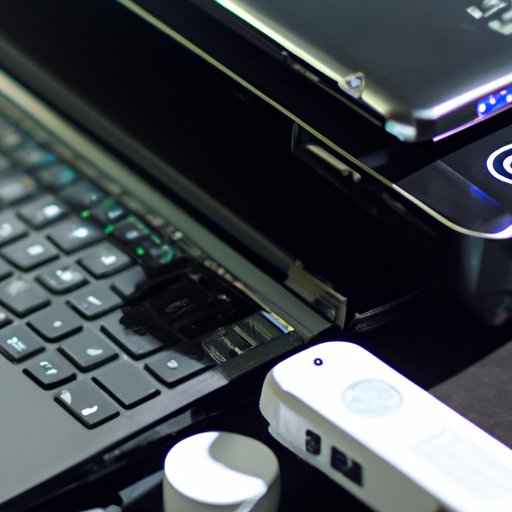Introduction
It’s a common problem: you want to watch a movie or stream a show from your laptop, but the screen is too small. Instead of squinting at your laptop, why not connect it to your TV? Connecting a laptop to a TV allows you to enjoy your favorite content on a larger screen. In this article, you’ll learn how to connect your laptop to your TV using wired and wireless options, streaming devices, docking stations, projectors, and adapters. By the end of this article, you’ll be able to choose the best method for your setup and troubleshoot common problems.
Wired Connections
If you want a reliable, high-quality connection, a wired connection is best. There are several different types of cables available:
- HDMI: High-Definition Multimedia Interface
- VGA: Video Graphics Array
- DVI: Digital Visual Interface
- DisplayPort: A digital audio and video interface
Each cable has its advantages and disadvantages. HDMI is the most popular cable since it supports both audio and video. VGA is an older cable that only carries video signals, but it’s still widely used. DVI is similar to VGA but carries a digital signal rather than an analog one. DisplayPort is a newer cable that’s becoming more common and supports higher resolutions.
To connect your laptop to your TV using a wired connection, first, check what type of ports your laptop and TV have. Then, choose the appropriate cable for your setup. Next, plug one end of the cable into your laptop and the other end into your TV. Finally, switch the input on your TV to the appropriate HDMI, VGA, DVI, or DisplayPort input to see your laptop screen on your TV.
Wireless Connections
Wireless connections are convenient, but may not provide the same quality as a wired connection. There are several options available:
- Miracast: A wireless display standard for streaming video and audio content from one device to another
- Chromecast: A streaming device that plugs into your TV’s HDMI port and allows you to stream content from your laptop, phone, or tablet
- Apple AirPlay: A wireless protocol for streaming content from an Apple device to an Apple TV
While wireless connections are convenient, they may suffer from lag or quality issues. To set up a wireless connection, ensure your laptop and TV support the same technology (e.g., Miracast). Follow the instructions for your device to establish a connection and start streaming.
Using a Streaming Device
Streaming devices are an easy and convenient way to connect your laptop to your TV. There are several options available:
- Roku: A streaming device that provides access to popular streaming services and requires an HDMI port
- Amazon Fire TV: A device that streams content from services like Amazon Prime Video and Netflix
- Apple TV: A streaming device that provides access to Apple TV+ and other services and requires an HDMI port
To use a streaming device, simply connect the device to your TV, download the app to your laptop, and start streaming.
Using a Docking Station
A docking station is a device that allows you to connect your laptop to external displays, but they can also be used to connect your laptop to your TV. A docking station usually connects to your laptop via USB or Thunderbolt and provides additional ports such as HDMI or VGA. This setup is convenient if you frequently work from home and need to connect to multiple external displays.
Connect the docking station to your laptop and your TV using the appropriate cables. Then, switch the input on your TV to the appropriate HDMI or VGA input.
Using a Projector
If you don’t have a TV, you can use a projector to display your laptop screen on a larger screen. While this setup is less common, it can be useful for presentations or movie nights. Connect your laptop to the projector using a VGA or HDMI cable. Adjust the settings on your laptop to extend your display to the projector.
Adapter Options
If your laptop or TV doesn’t have the appropriate port, you may need an adapter. There are several options available:
- USB-C to HDMI: An adapter that connects your USB-C port to an HDMI port
- Mini DisplayPort to HDMI: An adapter that connects your Mini DisplayPort to an HDMI port
- USB to HDMI: An adapter that connects your USB port to an HDMI port
Choose the appropriate adapter for your setup and plug it into your laptop and TV. Then, switch the input on your TV to the appropriate HDMI input.
Troubleshooting Tips
If you’re having trouble connecting your laptop to your TV, here are some common problems and solutions:
- No sound: Check that the volume is turned up on your TV and your laptop. Ensure that the correct audio output is selected on your laptop.
- Display resolution issues: Make sure that the display resolution is set correctly on your laptop and TV. Try adjusting the settings on your laptop to match your TV.
If you’re still having trouble, consult the instruction manual for your device or seek assistance from a professional.
Conclusion
There are many ways to connect your laptop to your TV, from wired to wireless options, docking stations, projectors, and adapters. Each method has its advantages and disadvantages, so it’s essential to choose the best one for your needs. Don’t be afraid to experiment with different options to find what works best for your setup. Remember to troubleshoot any issues that may arise and seek assistance if needed.
